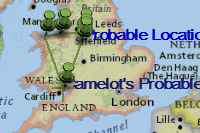Warning and Remorse
In this warm and welcome castle, sleep soundly.
The revelry has ended with time to spare for lasting rest,
For the lord and lady of this land, this kindly keep, must
Come morning hunt for themselves a morsel for their savoring.
The princely paladin—your proficient provider—sends to procure
A portly pig. He’ll plant his point where the pool meets the precipice,
Carrying the rightly collected cadaver to cook and contribute in
Account of your corroborated accord: a gift to grant good Gawain in
Christmastime. But the lady has another prey in mind.
Good knight, tonight you lock yourself away to accept
A trial: A more creeping demon than her lovely face implies
seeks to cleverly dishonor you in all your knightly glory.
Her seductive glare—sent to test your chivalrous wit—
Is masked by a gentle, courtly allure. Your veracity would be her meal,
Drawn from your lips like the blood of the delicious swine, though a venom to kill the truth: the troth you profess in all sincerity.
The husband
hunts for vicious beasts
In the early morning dew.
Will you become a pleasant feast
For his wife to seek and chew?
The scratch on your nape will scar with the smart of your sin.
The green sash with which you replaced the Ephesians’ Belt
girded you with far fewer promises and protections.
Had you held wholly to your holy behavior, your flinching furrows
would never have feared the floor. When you learned of Bertilak
and his beautiful bride’s arrangement, did you find yourself
outmaneuvered or dishonored? Bested or proven less than knightly?
Carry home the axe and dress the broken pentangle with the memory
Of your fallacy, the ornamental gift you never gave in recompense.
But return to your King. The Table will surely slay the fatted calf
In celebration of their fellow knight’s return from a most assured demise.
Tell them the tale of Sir Gawain, the nephew that overcame the beast and fell to himself. Let them know the shame you bear, for they will share in your failures.
Gawain,
The Green Knight sealed away
Your place at Arthur’s side.
But by the shame of that sash’s sway
In humility you’ll reside.



